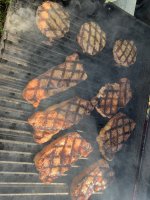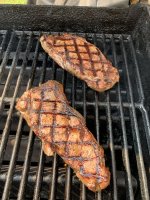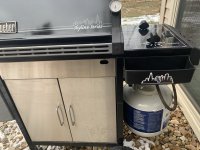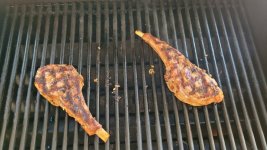Jon Tofte
TVWBB 1-Star Olympian
OK, I get it that some of you are tired of the GrillGrates debate. I am not posting to restart any arguments or question those who raise potentially serious concerns about cooking on aluminum. It seems, however, that most of the discussion in favor of GrillGrates centers around the nice grill marks they produce:


They certainly do, but truth be told, you can produce some really nice marks with cast iron and with good stainless rods. Here's something I did on the same grill as in the first picture above, but with cast iron grates installed instead:

So, you don't really have to have GrillGrates if you want nice sear marks. (Whether that matters is a separate discussion, but I will readily admit here that it has NOTHING to do with making the meat taste any better.) Anyway, given that GrillGrates are not the only path for bold sear marks, is there any other good reason to use them?
I would submit this for consideration: I did a quicky makeover where I put a Skyline hood on a late Silver A body. For now, this is my daily driver:

I replaced the burners, and I decided that the large gap between the two burners might be a great application for GrillGrates because of their ability to help smooth out hot/cold spots. I used them for quite a while through the winter and early spring. POINT 1 in favor of GrillGrates is that the are aluminum and can't rust - especially nice for a grill sitting out in the wet, cold winter. GrillGrates are not very hard to maintain compared to cast iron, which is really my sentimental favorite. I get that stainless rod grates will likewise not rust, but there is something more important: POINT 2 during the time I used GrillGrates on my custom Skyline, the interior of my grill stayed amazingly clean. Very little ever fell to the main drip tray or small grease pan.
So, here comes summer, and for various reasons I decided to swap out my GrillGrates for cast iron. First cook didn't go well as I had to get re-used to using regular grates on this grill. Interestingly, I found that the little 2-burner Silver A is capable of producing a LOT of heat and does so fairly evenly. I got the hang of it pretty soon and was able to produce decent results, picture 3 above being an example. However, burgers and steaks made a mess out of my main drip tray and filled the small pan with grease. I had to do the basic remove the trays, flavorizer bars, etc. and scrape away everything regularly. The one time I didn't do it soon enough I was trying to fend off a grease fire. My burners also had to be brushed to keep them working well.
So, my submission here is that it is hard to not appreciate how GrillGrates incinerates a lot of what fills your firebox, grease tray, and drip pan with grease up above at the grate level. Really, the deep valleys in GrillGrates work a lot like Weber intended flavorizer bars to work. Yes, you do have to scrape the valleys out periodically, but the give you a tool for that. You just push the dried up stuff to the back. When there is too much, you remove the GrillGrates and brush into the trash.
I don't expect to change any minds here, but I thought it was worth consideration of this benefit (Point 2) of GrillGrates which is really a lot more significant than the often discussed grill marks they make.
With some leaves on the ground already here in Indiana, I have just switched back to GrillGrates. My first cook went "Grate!"


They certainly do, but truth be told, you can produce some really nice marks with cast iron and with good stainless rods. Here's something I did on the same grill as in the first picture above, but with cast iron grates installed instead:

So, you don't really have to have GrillGrates if you want nice sear marks. (Whether that matters is a separate discussion, but I will readily admit here that it has NOTHING to do with making the meat taste any better.) Anyway, given that GrillGrates are not the only path for bold sear marks, is there any other good reason to use them?
I would submit this for consideration: I did a quicky makeover where I put a Skyline hood on a late Silver A body. For now, this is my daily driver:

I replaced the burners, and I decided that the large gap between the two burners might be a great application for GrillGrates because of their ability to help smooth out hot/cold spots. I used them for quite a while through the winter and early spring. POINT 1 in favor of GrillGrates is that the are aluminum and can't rust - especially nice for a grill sitting out in the wet, cold winter. GrillGrates are not very hard to maintain compared to cast iron, which is really my sentimental favorite. I get that stainless rod grates will likewise not rust, but there is something more important: POINT 2 during the time I used GrillGrates on my custom Skyline, the interior of my grill stayed amazingly clean. Very little ever fell to the main drip tray or small grease pan.
So, here comes summer, and for various reasons I decided to swap out my GrillGrates for cast iron. First cook didn't go well as I had to get re-used to using regular grates on this grill. Interestingly, I found that the little 2-burner Silver A is capable of producing a LOT of heat and does so fairly evenly. I got the hang of it pretty soon and was able to produce decent results, picture 3 above being an example. However, burgers and steaks made a mess out of my main drip tray and filled the small pan with grease. I had to do the basic remove the trays, flavorizer bars, etc. and scrape away everything regularly. The one time I didn't do it soon enough I was trying to fend off a grease fire. My burners also had to be brushed to keep them working well.
So, my submission here is that it is hard to not appreciate how GrillGrates incinerates a lot of what fills your firebox, grease tray, and drip pan with grease up above at the grate level. Really, the deep valleys in GrillGrates work a lot like Weber intended flavorizer bars to work. Yes, you do have to scrape the valleys out periodically, but the give you a tool for that. You just push the dried up stuff to the back. When there is too much, you remove the GrillGrates and brush into the trash.
I don't expect to change any minds here, but I thought it was worth consideration of this benefit (Point 2) of GrillGrates which is really a lot more significant than the often discussed grill marks they make.
With some leaves on the ground already here in Indiana, I have just switched back to GrillGrates. My first cook went "Grate!"




